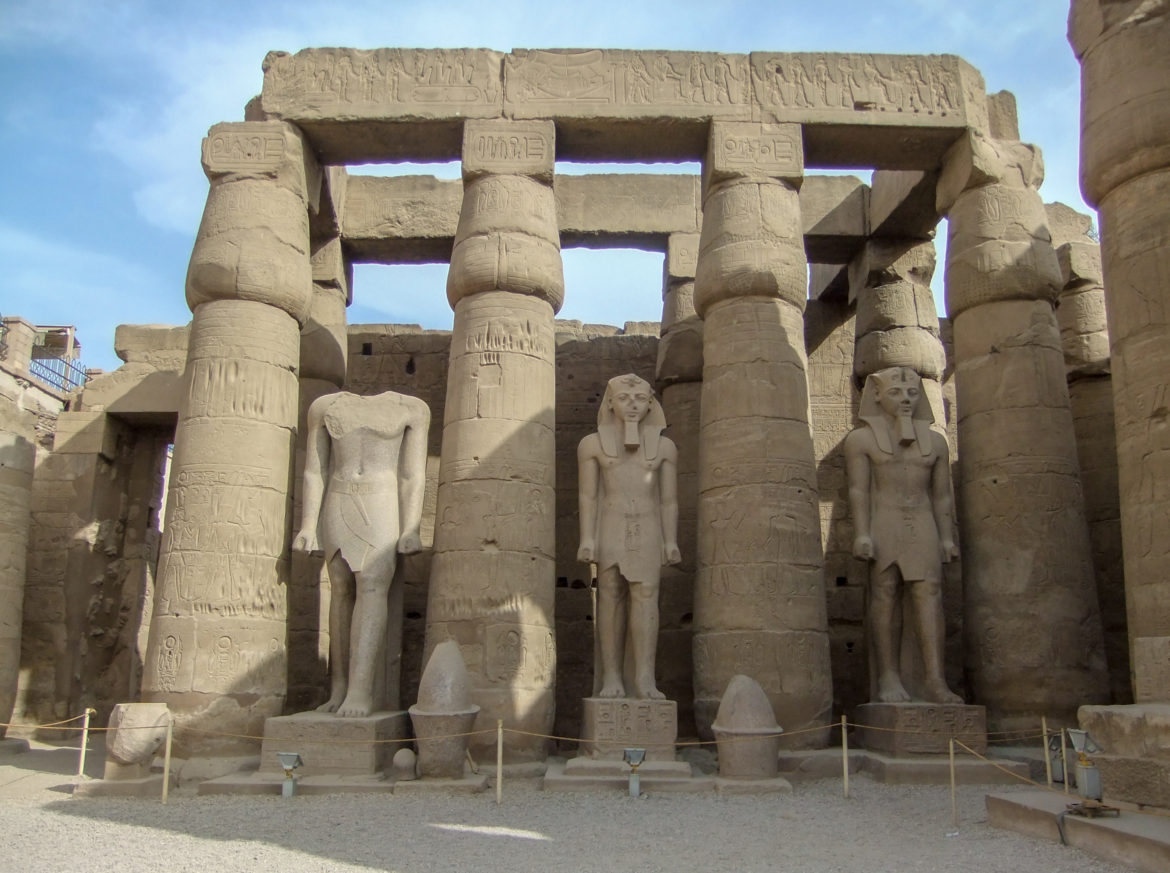As the World’s Largest Outdoor Museum, Egypt’s Luxor sites are an archeological paradise. It grandly exhibits the history of Upper Egypt in the New Kingdom. From the Red Sea port, Safaga, I experienced the main Luxor travel attractions all in one day: Valley of the Kings, Luxor Temple, Temple of Queen Hatshepsut and Colossi of Memnon.
Known as the ancient city of Thebes, Luxor was the capital of Upper Egypt during the New Kingdom. Constructed in 1400 BCE. on the East Bank of the Nile, Thebes remained the religious capital of Egypt until the Greek Period. The main God of the city was Amun, along with the Goddess (his wife) Mut and their son, Khonsu. Amun rose the ranks of the Sun God, Ra and thus, became known as Amun-Ra.
Often referred to as the “world’s largest open-air museum,” Luxor monuments are an extraordinary way to experience this era of Egyptian history. Most noteworthy, its 2 primary cult temples on the East Bank are Karnak and Luxor Temple. Luxor temple is not dedicated to a cult God. Instead, Luxor Temple represents the renewal of kingship and may be where the Pharaohs were crowned. In comparison, Karnak is the largest temple in the world, dedicated to the cult Gods of the Theban Triad: Amun, Mut and Knonsu. Furthermore, Valley of the Kings and Queens replaced the pyramids for pharaoh burials with tombs, elaborate catacombs and sarcophagi.
Attractions near Luxor in a Day
Luxor Temple
Amenhotep III built the Luxor Temple. Later, Ramses II connected it with Karnak Temple by a row of sphinxes. This temple’s main function was the annual Opet celebrations, when the statues of Amun, Mut and Khonsu transferred from Karnak, along the Avenue of Sphinxes.
Before exploring the temple, brush up on your Egyptian mythology to get the most of your tour. The main God of the city was Amun, along with the Goddess (his wife) Mut and their son, Khonsu. Amun rose the ranks of the Sun God, Ra and thus, became known as Amun-Ra. Most importantly, visit in the early morning before the crowds arrive or at night with the mysterious lighting.
Valley of the Kings
On the West Bank of the Nile, this famous archeological dig does not allow photography inside the burials. Thus, sorry no photos. For almost 500 years (16th-11th century BC) Valley of the Kings is where the excavated rock tombs and catacombs elaborately became constructed for the pharaohs and nobles of the New Kingdom. Additionally, 1000 feet of limestone cliffs embed the Valley of the Kings.
To put in perspective, most of the Egyptian pyramids were built as tombs for the pharaohs and their consorts in the Old and Middle Kingdom periods. However, in the New Kingdom they no longer built pyramids and replaced their burials in more secure catacombs and tombs underground. Plus, the Royal tombs feature drawings and patterns of ancient Egyptian mythology. Mummification preserved the bodies, to take them along for a spiritual afterlife. Overall, 62 known tombs dwell here, including the well-known Tutankhanum or King Tut. Most noteworthy, this monument is known as one of the most famous archeological sites in the world.
Mortuary Temple of Queen Hatshepsut
Near the Valley of the Kings the Temple of Queen Hatshepsut is dedicated to the female pharaoh of Egypt, that died in 1458 BC. It’s located beneath a dramatic cliff on the west bank of the Nile. Furthermore, the relief sculpture inside the temple recounts the tale of the divine birth of a female pharaoh.
Colossi of Memnon
At Colossi of Memnon stands two large sandstone statues of the Pharaoh Amenhotep III. He reigned during the 18th Dynasty of Egypt. Located west of Luxor these statues stand east towards the Nile, at 60 feet (18 m) high. The king is sitting on a throne with symbolic engravings.
Lastly, I love this left photo taken at the Colossi of Memnon with a friend from my ship and a local, who requested a tip. I gladly paid him for this fun photo. This was the grand finale to a fantastic day.
Enjoy Luxor!
This region is an archeological nirvana taking us to the extraordinary time of the Egyptian New Kingdom. Therefore, it should be on the Bucket List of everyone interested in Egyptian history and archeology.
Read More!
A Fantastic, Must-See Suez Canal Cruise
Walking with the Lions at Mauritius Casela Park & Ethical Questions







